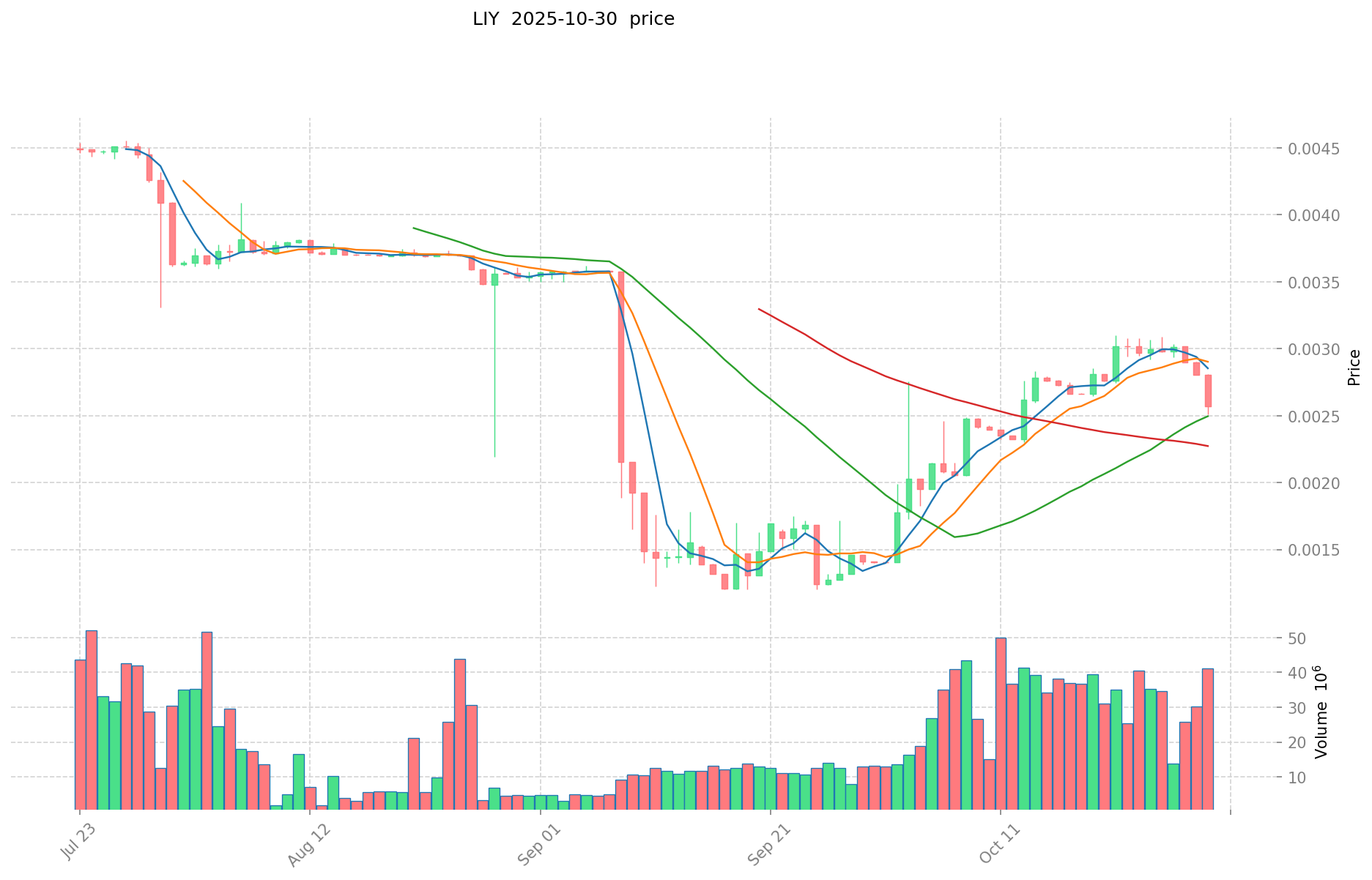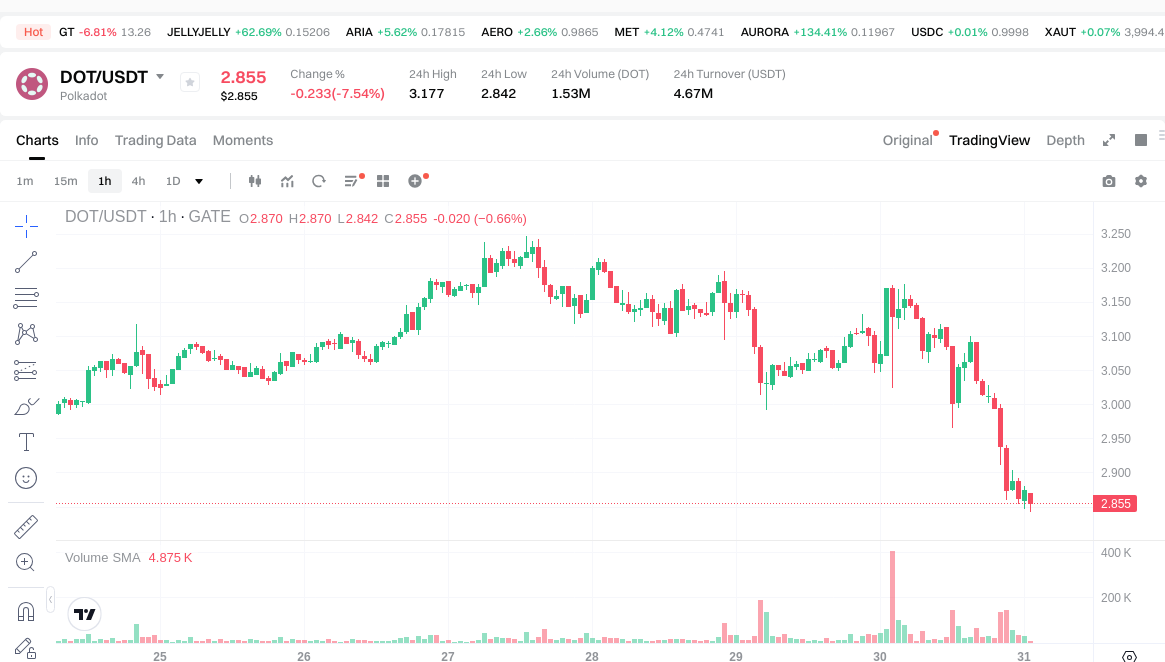LIY vs DOT: The Battle for Dominance in Cryptocurrency Markets
Introduction: LIY vs DOT Investment Comparison
In the cryptocurrency market, the comparison between Lily (LIY) vs Polkadot (DOT) has always been an unavoidable topic for investors. The two not only show significant differences in market cap ranking, application scenarios, and price performance, but also represent different positions in the crypto asset landscape.
Lily (LIY): Since its launch, it has gained market recognition for its next-generation live commerce with web3 token incentive protocol.
Polkadot (DOT): Since its inception in 2020, it has been hailed as a platform for connecting various blockchains, and is one of the cryptocurrencies with the highest global trading volume and market capitalization.
This article will provide a comprehensive analysis of the investment value comparison between LIY and DOT, focusing on historical price trends, supply mechanisms, institutional adoption, technological ecosystems, and future predictions, attempting to answer the question that investors are most concerned about:
"Which is the better buy right now?"
I. Price History Comparison and Current Market Status
LIY (Lily) and DOT (Polkadot) Historical Price Trends
- 2025: LIY reached an all-time high of $0.0575 on January 15, then dropped to an all-time low of $0.000322 on February 10.
- 2021: DOT hit its all-time high of $54.98 on November 4, driven by the growing interest in interoperability solutions.
- Comparative analysis: In this market cycle, LIY experienced extreme volatility, dropping 99.44% from its peak to trough within a month. Meanwhile, DOT has declined 94.38% from its all-time high to the current price.
Current Market Situation (2025-10-31)
- LIY current price: $0.002207
- DOT current price: $2.871
- 24-hour trading volume: LIY $58,619.56 vs DOT $4,691,809.91
- Market Sentiment Index (Fear & Greed Index): 34 (Fear)
Click to view real-time prices:
- Check LIY current price Market Price
- Check DOT current price Market Price


II. Core Factors Influencing LIY vs DOT Investment Value
Supply Mechanism Comparison (Tokenomics)
- LIY: Limited supply model with deflationary characteristics
- DOT: Inflationary model with staking rewards and governance mechanisms
- 📌 Historical Pattern: Supply mechanisms drive cyclical price movements with deflationary assets typically showing higher volatility during market transitions.
Institutional Adoption and Market Applications
- Institutional Holdings: DOT has gained more institutional traction through parachain investments
- Enterprise Adoption: DOT offers cross-chain infrastructure for enterprise solutions while LIY focuses on specific financial applications
- Regulatory Attitudes: Regulatory frameworks vary by jurisdiction with increasing clarity for both assets
Technical Development and Ecosystem Building
- DOT Technical Upgrades: Parachains and cross-chain interoperability expanding ecosystem capabilities
- LIY Technical Development: Focus on scalability and transaction efficiency improvements
- Ecosystem Comparison: DOT has broader DeFi integration and smart contract functionality, while LIY maintains specialized application focus
Macroeconomic Factors and Market Cycles
- Inflation Environment Performance: Both assets show correlation with broader market trends rather than independent inflation hedging
- Monetary Policy Impact: Interest rates and USD index fluctuations affect trading volumes and liquidity
- Geopolitical Factors: Cross-border transaction demand influences adoption rates in different regions
III. 2025-2030 Price Prediction: LIY vs DOT
Short-term Prediction (2025)
- LIY: Conservative $0.00145993 - $0.002179 | Optimistic $0.002179 - $0.00278912
- DOT: Conservative $2.13825 - $2.851 | Optimistic $2.851 - $3.87736
Mid-term Prediction (2027)
- LIY may enter a growth phase, with prices expected in the range of $0.00224559024 - $0.003705223896
- DOT may enter a bullish market, with prices expected in the range of $2.78554104 - $5.28849096
- Key drivers: Institutional capital inflow, ETFs, ecosystem development
Long-term Prediction (2030)
- LIY: Base scenario $0.004305874373395 - $0.005769871660349 | Optimistic scenario $0.005769871660349+
- DOT: Base scenario $6.620177390904 - $9.73166076462888 | Optimistic scenario $9.73166076462888+
Disclaimer: This analysis is based on historical data and market projections. Cryptocurrency markets are highly volatile and unpredictable. This information should not be considered as financial advice. Always conduct your own research before making investment decisions.
LIY:
| 年份 | 预测最高价 | 预测平均价格 | 预测最低价 | 涨跌幅 |
|---|---|---|---|---|
| 2025 | 0.00278912 | 0.002179 | 0.00145993 | -1 |
| 2026 | 0.0031299156 | 0.00248406 | 0.0021362916 | 12 |
| 2027 | 0.003705223896 | 0.0028069878 | 0.00224559024 | 27 |
| 2028 | 0.00429805971936 | 0.003256105848 | 0.00198622456728 | 47 |
| 2029 | 0.00483466596311 | 0.00377708278368 | 0.003134978710454 | 71 |
| 2030 | 0.005769871660349 | 0.004305874373395 | 0.002755759598972 | 95 |
DOT:
| 年份 | 预测最高价 | 预测平均价格 | 预测最低价 | 涨跌幅 |
|---|---|---|---|---|
| 2025 | 3.87736 | 2.851 | 2.13825 | 0 |
| 2026 | 4.709852 | 3.36418 | 2.3885678 | 17 |
| 2027 | 5.28849096 | 4.037016 | 2.78554104 | 40 |
| 2028 | 6.0149519892 | 4.66275348 | 4.4762433408 | 62 |
| 2029 | 7.901502047208 | 5.3388527346 | 4.591413351756 | 85 |
| 2030 | 9.73166076462888 | 6.620177390904 | 6.22296674744976 | 130 |
IV. Investment Strategy Comparison: LIY vs DOT
Long-term vs Short-term Investment Strategy
- LIY: Suitable for investors focused on live commerce and web3 token incentive protocols
- DOT: Suitable for investors interested in interoperability solutions and broader blockchain ecosystem development
Risk Management and Asset Allocation
- Conservative investors: LIY: 20% vs DOT: 80%
- Aggressive investors: LIY: 40% vs DOT: 60%
- Hedging tools: Stablecoin allocation, options, cross-currency portfolios
V. Potential Risk Comparison
Market Risk
- LIY: High volatility and relatively low trading volume
- DOT: Susceptible to broader crypto market trends and competition from other interoperability solutions
Technical Risk
- LIY: Scalability, network stability
- DOT: Parachain auction dynamics, cross-chain security challenges
Regulatory Risk
- Global regulatory policies may have differing impacts on both assets, with DOT potentially facing more scrutiny due to its broader ecosystem
VI. Conclusion: Which Is the Better Buy?
📌 Investment Value Summary:
- LIY advantages: Next-generation live commerce focus, deflationary supply mechanism
- DOT advantages: Established ecosystem, institutional adoption, interoperability solutions
✅ Investment Advice:
- New investors: Consider a higher allocation to DOT for its established market presence
- Experienced investors: Balanced approach with both assets, leveraging LIY's growth potential
- Institutional investors: Focus on DOT for its broader ecosystem and institutional-grade solutions
⚠️ Risk Warning: The cryptocurrency market is highly volatile. This article does not constitute investment advice. None
VII. FAQ
Q1: What are the main differences between LIY and DOT? A: LIY focuses on next-generation live commerce with web3 token incentives, while DOT is a platform for connecting various blockchains. LIY has a limited supply model with deflationary characteristics, whereas DOT has an inflationary model with staking rewards. DOT has broader DeFi integration and smart contract functionality, while LIY maintains a specialized application focus.
Q2: Which cryptocurrency has shown better price performance historically? A: DOT has shown more stable long-term price performance. It reached an all-time high of $54.98 in November 2021 and has declined 94.38% since then. LIY, on the other hand, experienced extreme volatility in 2025, dropping 99.44% from its peak to trough within a month.
Q3: How do the supply mechanisms of LIY and DOT differ? A: LIY has a limited supply model with deflationary characteristics, which typically leads to higher volatility during market transitions. DOT employs an inflationary model with staking rewards and governance mechanisms, which can provide more stability but may lead to gradual value dilution over time.
Q4: Which cryptocurrency has greater institutional adoption? A: DOT has gained more institutional traction through parachain investments and offers cross-chain infrastructure for enterprise solutions. It also has broader DeFi integration and smart contract functionality, making it more attractive for institutional investors.
Q5: What are the long-term price predictions for LIY and DOT? A: By 2030, LIY is predicted to reach a base scenario of $0.004305874373395 - $0.005769871660349, with an optimistic scenario of $0.005769871660349+. DOT is expected to reach a base scenario of $6.620177390904 - $9.73166076462888, with an optimistic scenario of $9.73166076462888+.
Q6: How should investors allocate their portfolio between LIY and DOT? A: Conservative investors might consider allocating 20% to LIY and 80% to DOT, while aggressive investors could opt for 40% LIY and 60% DOT. The exact allocation should depend on individual risk tolerance and investment goals.
Q7: What are the main risks associated with investing in LIY and DOT? A: LIY faces high volatility and relatively low trading volume risks, as well as potential scalability and network stability issues. DOT is susceptible to broader crypto market trends, competition from other interoperability solutions, and faces challenges related to parachain auction dynamics and cross-chain security.
Share
Content